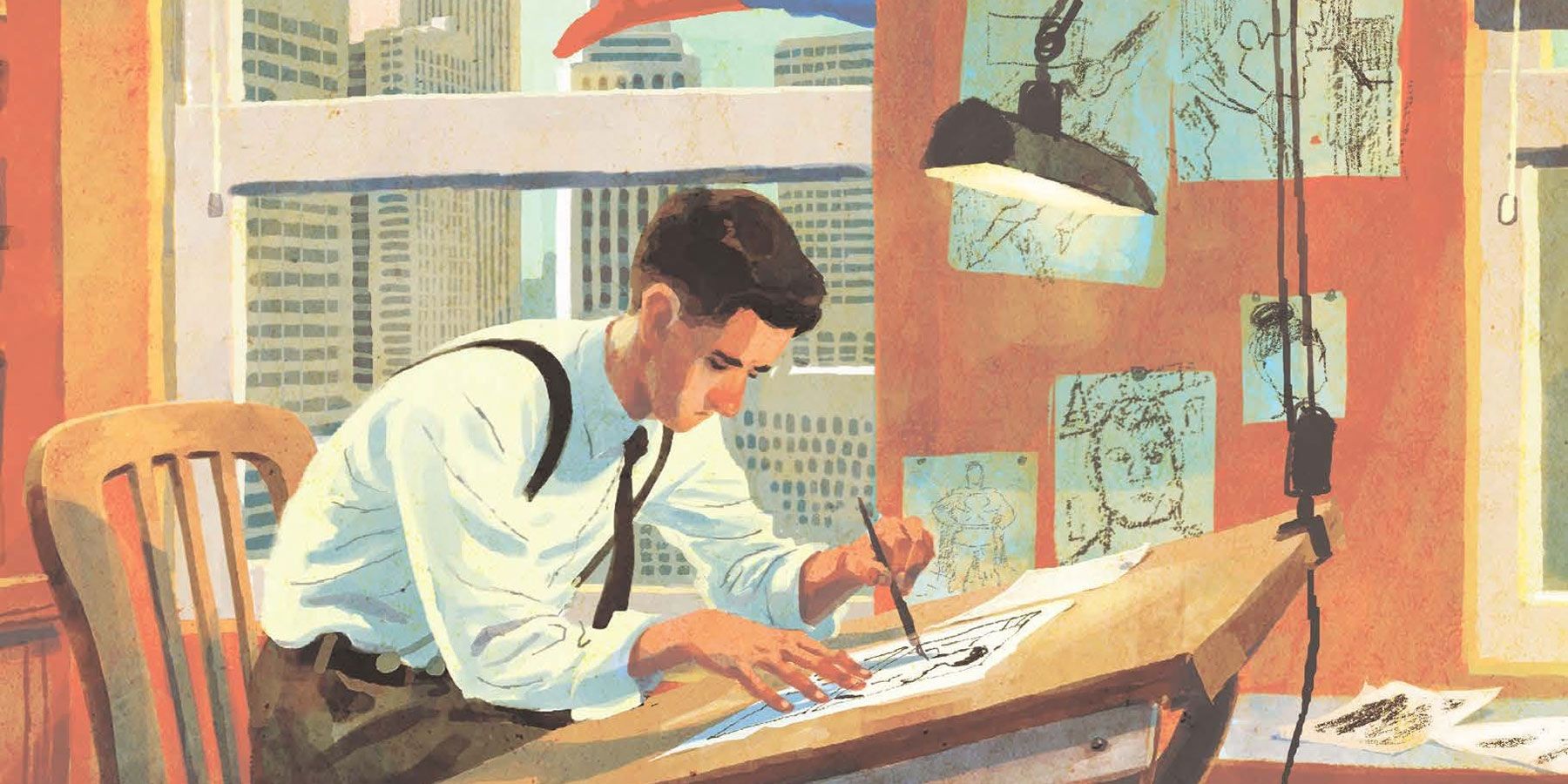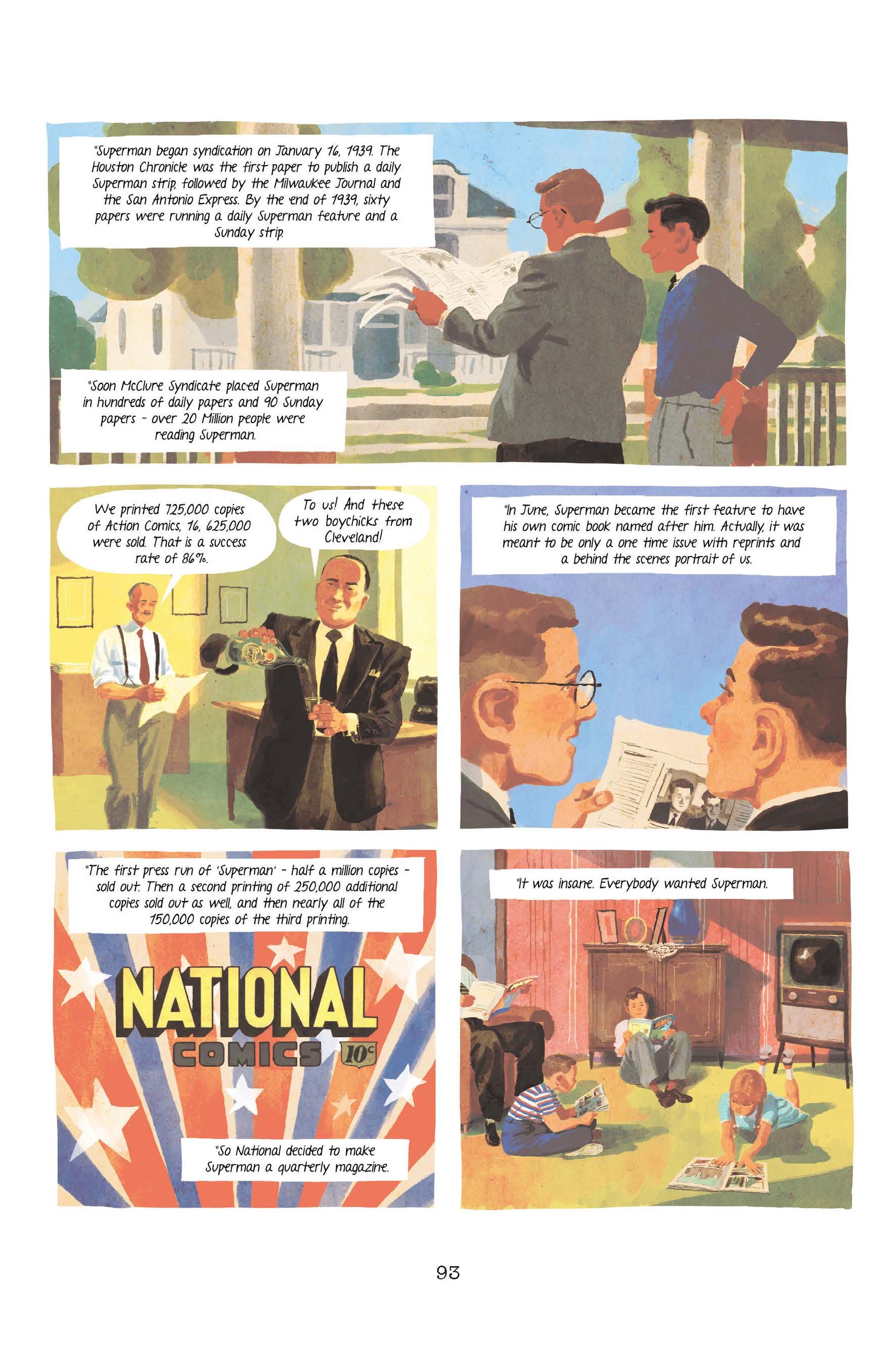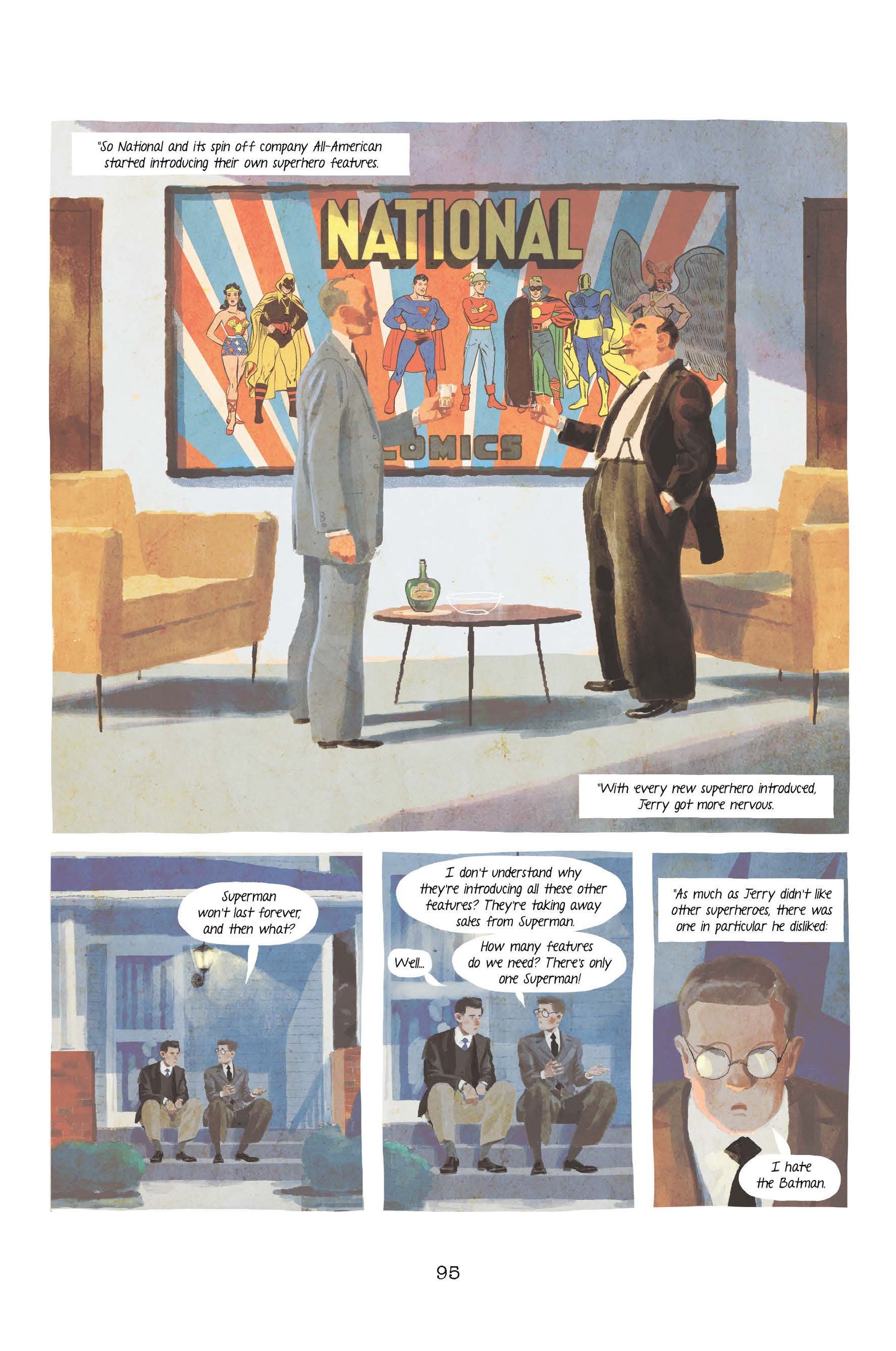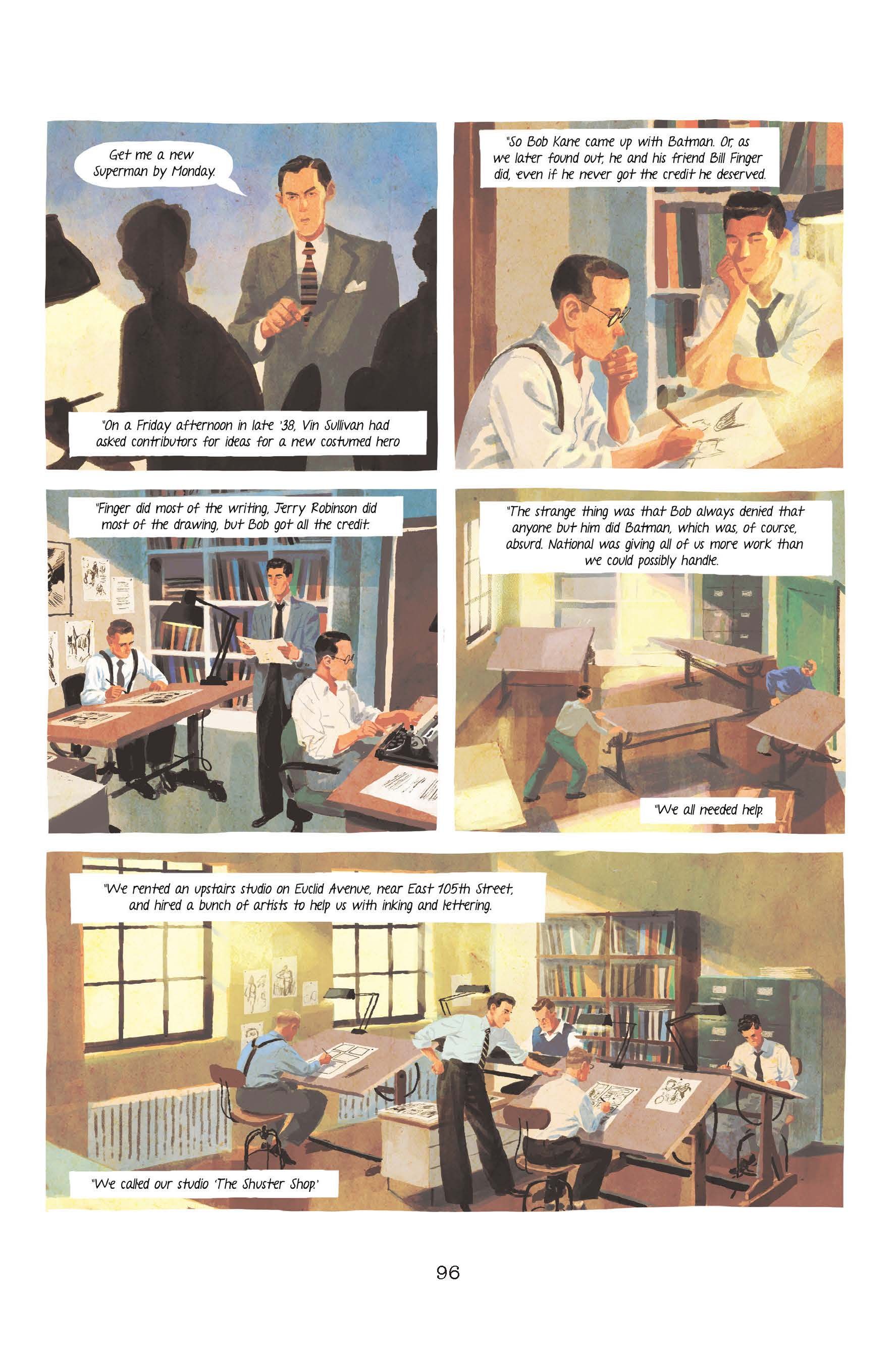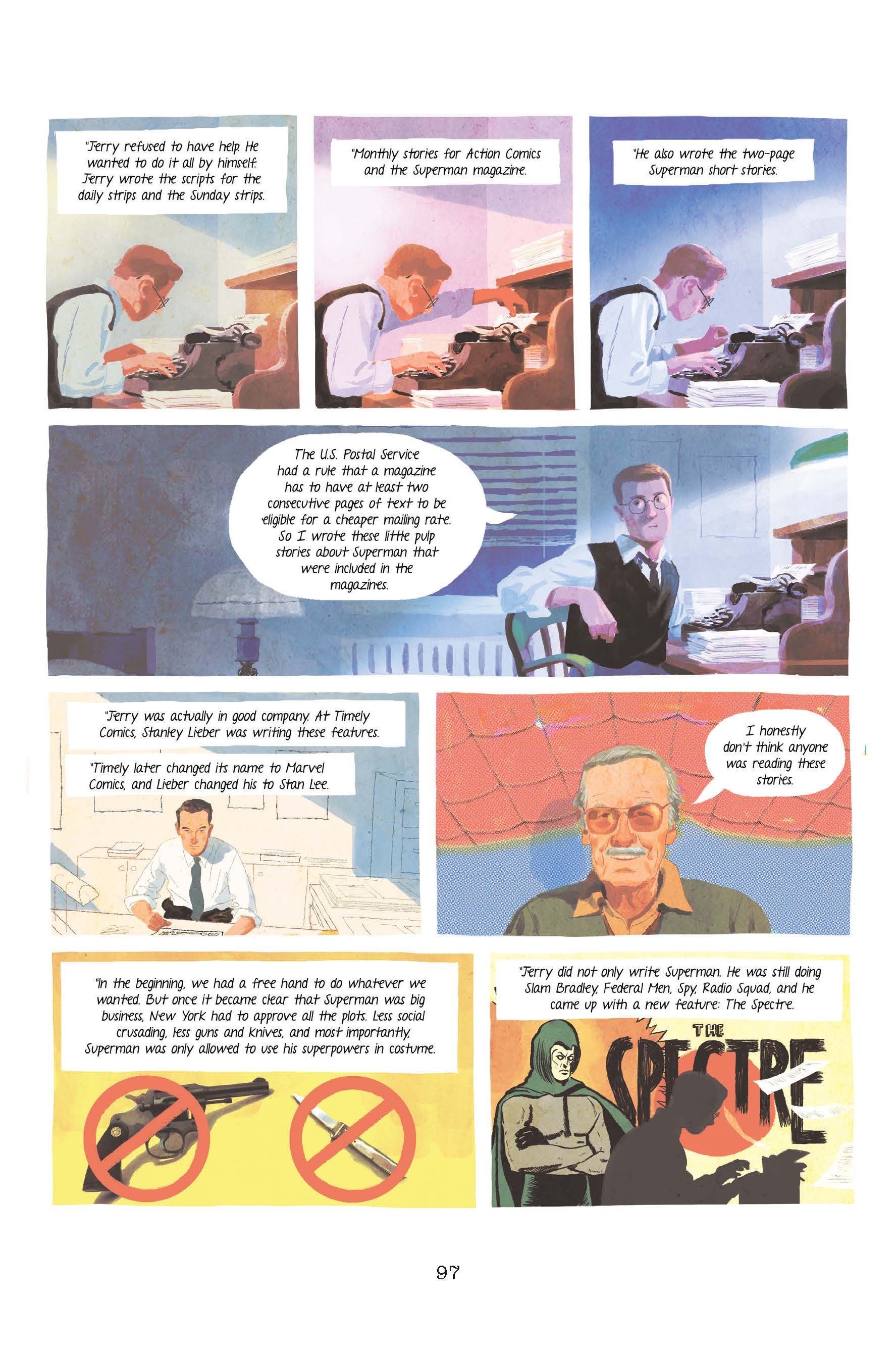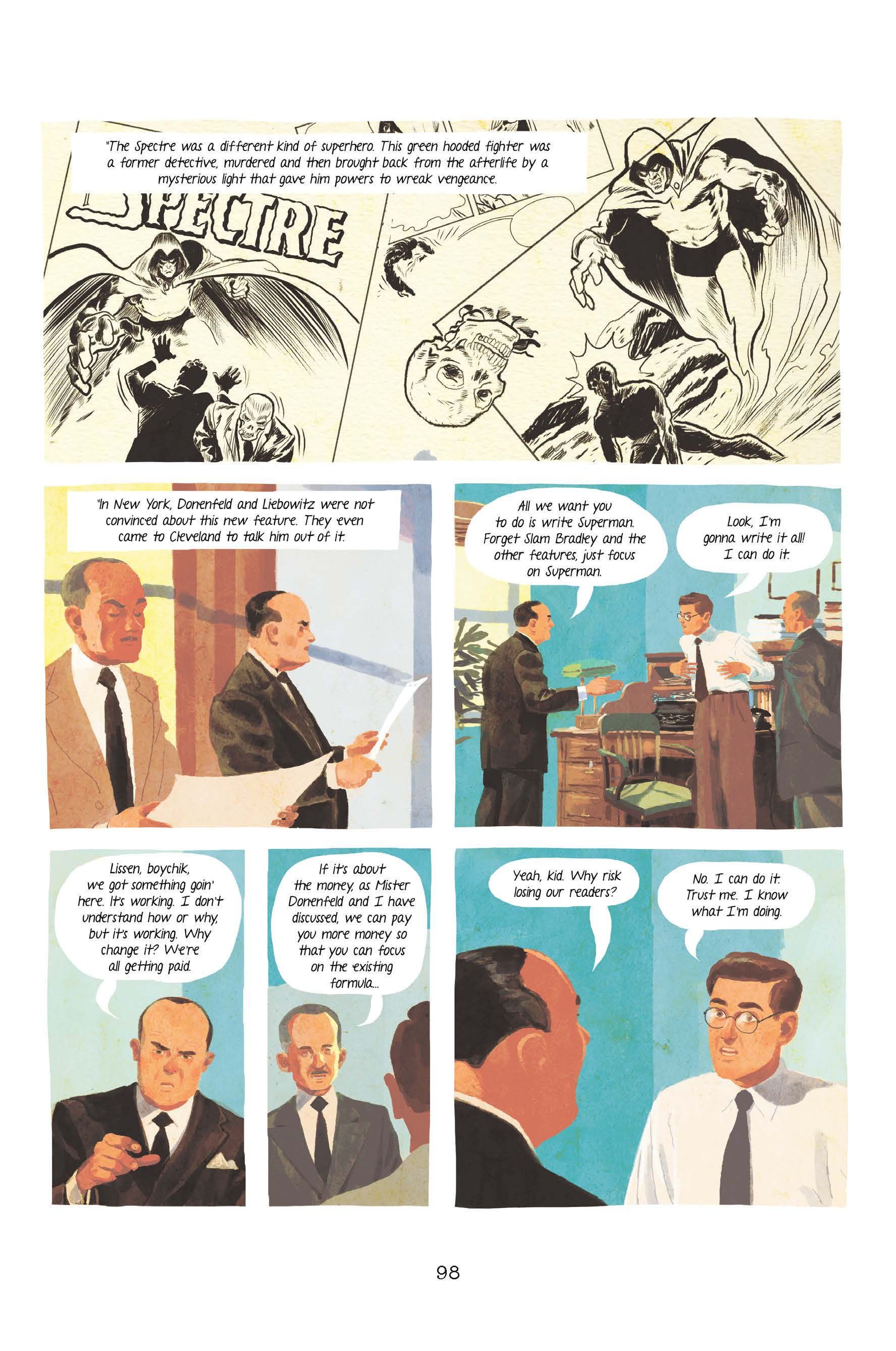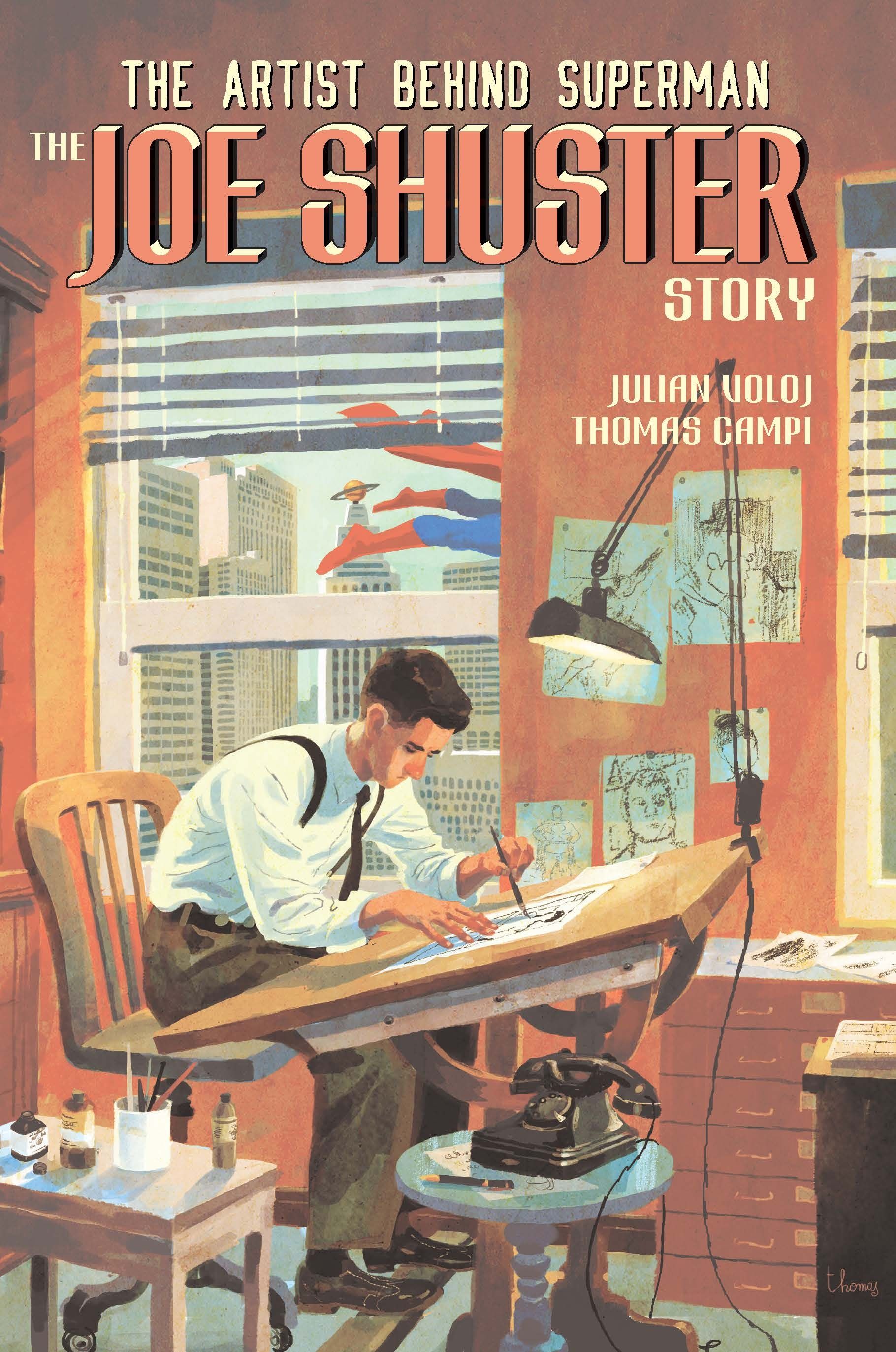Joe Shuster changed everything. When he drew that squinty man in the circus leotard lifting an automobile over his head and smashing it down onto a rocky outcropping -- with the panicky gangster fleeing in disbelief toward the reader -- he fired the imagination of countless children. Comic books -- all of popular culture, really -- could never possibly be the same again.
Shuster’s own story and tragedy are well known in the comics community, including the sale of Superman for only $130, his failing eyesight and inability to continue drawing, and his decline into anonymity and poverty before finally receiving recognition and a pension from DC Comics in the 1970s. Several insightful and valuable biographies and histories of Superman’s creators and of the comics medium as a whole have told Shuster’s story, but none has told that story in his native medium -- in comic book form.
Recently released from Super Genius (a Papercutz imprint), The Joe Shuster Story: The Artist Behind Superman finally presents Shuster’s tale, as well as that of his friend and Superman co-creator Jerry Siegel, via sequential art. Two experienced comic book biographers, writer Julian Voloj (author of Ghetto Brother: Warrior to Peacemaker) and illustrator Thomas Campi (Magritte: This is Not a Biography), bring Shuster’s story to four-color life.
RELATED: Magritte Comic Book Biography Captures the Artist’s Surrealist Spirit
“The focus on Joe Shuster came more by coincidence,” Voloj admitted in an interview with CBR. “When I was exploring the idea of turning the story into a graphic novel, I learned that someone donated a box of letters, written by Joe Shuster, to Columbia University. I contacted librarian Karen Green and got access to the letters even before they were fully catalogued.
“They were heartbreaking letters, most of them from around 1965-1970 when he was struggling to pay medical bills and fearing to be evicted," Voloj continued. "Reading about his hardship in his own words made me decide that he’d become the narrator.”
Keeping Shuster in the foreground was sometimes difficult, as the more assertive partner, Siegel, often took the lead in their creative, business and personal relationships. “Shuster was definitely the more quiet of the dynamic duo,” Voloj said. “Siegel was the more outspoken, the one who took initiative, be it negotiating with potential publishers (even before Superman) or deciding to go to court.
“The book is not only the story of Superman’s origins, but it is most of all the story of a friendship, and I think that Shuster often joined Siegel in his endeavors because of loyal friendship.”
Voloj went on about the decision to make Shuster the book’s core. “To me, Joe Shuster was the more tragic character: He was an illustrator who was losing his eyesight. He was in love with the Lois Lane model, and his friend Jerry Siegel ended up marrying her. Focusing on his perspective is a way to take him out of Jerry Siegel’s shadow; making him the narrator is giving him a voice.”
When the discussion turned to the already voluminous material about Siegel and Shuster, Voloj was quick to praise and cite many earlier histories. “Yes, that’s true and you can see that the graphic novel has nearly 20 pages of annotations, citing every great resource we used when doing the book. My interest in the American comic book history stems back to reading Michael Chabon’s fictionalized account in The Adventures of Kavalier and Clay and shortly afterwards Gerard Jones’ non-fiction book Men of Tomorrow. Then there is the amazingly researched Superboys by Brad Ricca, and not to forget the important work of Marc Tyler Nobleman and so many others. Superman created the whole industry, and to me, this was a story that had to be told in comic book form, paying homage to the artform itself.”
The comic book industry was essentially born with Action Comics #1, so in many ways, the history of Joe Shuster is the history of American comic books. After falling out with National/DC, Shuster’s search for work led him to briefly providing illustrations for Nights of Horror fetish pulps. That publisher’s legal problems coincided with the infamous Senate hearings on the connection between comics and juvenile delinquency, leaving Shuster fearful of public shame or legal repercussions.
“The book was never about Superman alone, but really a story about the American comic book history itself. Joe Shuster’s life is put into the wider historical context,” Voloj said of the book’s many historical connections. “He’s the child of Jewish immigrants, and like so many of his peers, he faced discrimination on the job market. The fact that most comic book pioneers were either of Jewish or Italian background had to do with the fact that they were barred from the advertising world. And once Superman became a success, they became the 'Mad Men' of comics. The Senate hearings are in this context important because they had many antisemitic undertones. They not only changed the face of the industry, but they were also a reminder that Jews were not totally accepted in post-World War II America.”
Excepting his role in several lawsuits to regain rights to or control of Superman, specific details of Shuster’s life are fleeting and anecdotal for nearly a quarter century from the early 1950s into the early or mid-'70s. While Voloj does paint a picture with the scant details known (for example, a famous instance of Shuster, working as a delivery man, presenting a package in the same building as National’s offices and being insulted by publisher Jack Liebowitz), he feels the lack of concrete information suits the tragedy of Shuster’s story.
He explained, “Losing Superman pushed both creators into obscurity, so in a way it is fitting that we don’t know much about their life. In the book’s narrative, the trial is a turning point, and we only see tidbits of Shuster’s post-Superman life. Both Siegel and Shuster did not only lose their creation, they were lost. And the industry that Superman created continued without them. Therefore the narrative focus broadens and we learn, for instance, about the readership’s changing tastes, the congressional hearings, etc. The story is told from Shuster’s perspective, so I imagined him still following developments, even if he is no longer part of it.”
Although both Siegel and Shuster have been gone for over twenty years now, more details about their lives - both personal and business - continue to be unearthed. Voloj and Campi’s book steers into the commonly told version of Jerry Siegel’s father’s death, that he was murdered during a hold-up, even though that story has recently been debunked.
Voloj explained, “Marc Tyler Nobleman proved that he was not shot, but rather died of a heart attack. In the illustrations, however, we play with the fact that it was for a long time unclear how he died. We see the robbery, but don’t know what exactly happened. For many years, Superman’s bulletproofness was related to the idea that Siegel’s father was shot, so leaving it open in the illustrations allows readers to come to this conclusion. However, the endnotes explain that he died of a heart attack.”
Another more recent revelation that made it into the book was Bob Kane’s role in Siegel and Shuster’s first lawsuit against DC/National -- namely, that Kane was asked to join the suit, but instead informed the company of the impending legal action to get better terms for himself with Batman’s ownership. “It is worth reading the endnotes to this scene,” Voloj said. “Nobleman actually uncovered the backstory related to Kane’s decision to inform the publishers. His father advised him not to join the lawsuit, and from his perspective, it was the right decision since he became the only winner of the lawsuit – by not being involved and renegotiating his contract.”
When the discussion turned to Superman’s impact, both Voloj and Campi believe Shuster and Siegel deserve all the credit for Superman’s success. “Superman was a game changer,” said Voloj. “As one can see in our book, Siegel and Shuster were influenced by contemporary pop culture and mixed different elements into a something new. It’s science fiction -- not from a distant future, but rather in the present. It’s not set on an exotic planet, but right here in an American city. Clark Kent has Zorro’s secret identity, but is at the same time an underdog like Harold Lloyd. All the puzzle pieces existed in the culture that surrounded these Cleveland youngsters, but they put them together into something different.”
Campi chimed in to expand on that thought and comment specifically on Shuster’s graphic appeal. “I think it’s very special. Joe Shuster was just a kid when he did the first drawings and actually graphically created Superman. Working on this book gave me the opportunity to study his work and I couldn’t help picturing this kid in the ’30s, those beautiful curvy cars, the suits with large pants, suspenders, wooden nib pens, big pieces of paper, no internet, no DVD, no smartphones; it’s all fascinating. He was making history without all the help we can have in this digital era."
"The artwork can seem naïve if seen through the eyes of somebody working digitally or simply used to modern aesthetics. I think it’s great if you put it in context," Campi continued. "I've studied and reproduced a few of his drawings for the book. The inking, and even the way he simplified anatomy, were pretty impressive for someone of his age who didn't have the amount of comics and references we have nowadays. Personally, I'm a big fan of those old-school styles, they have that sort of elegance that never gets old.”
The Joe Shuster Story: The Artist Behind Superman is available now from Super Genius.

